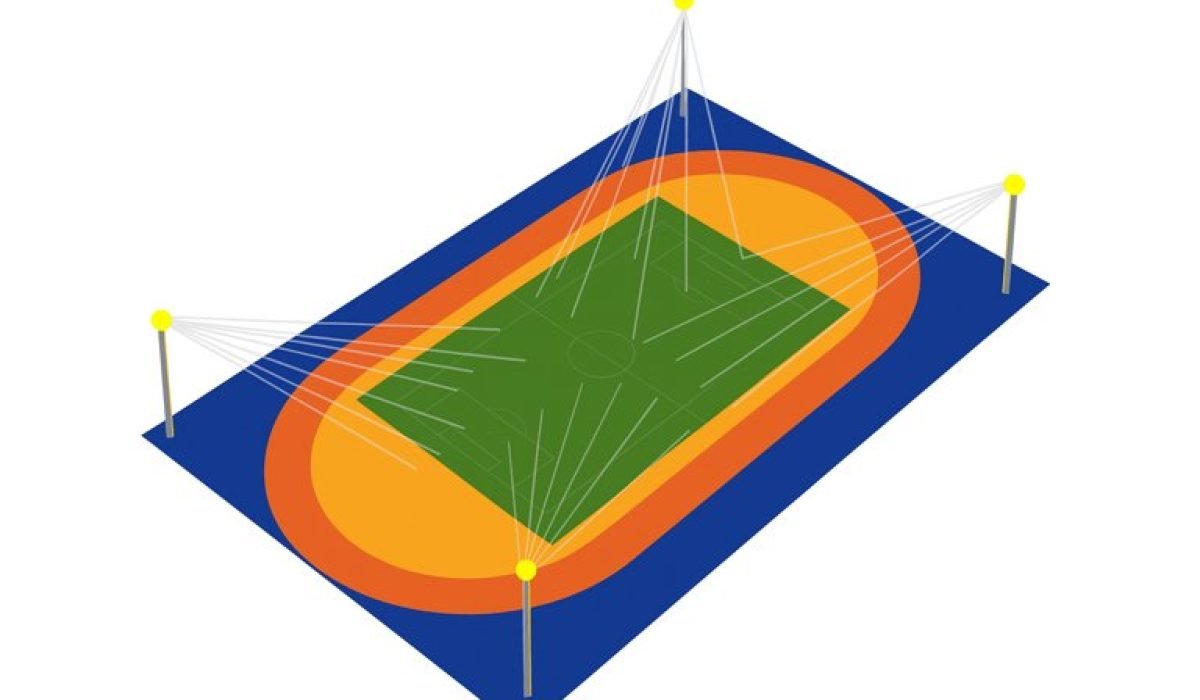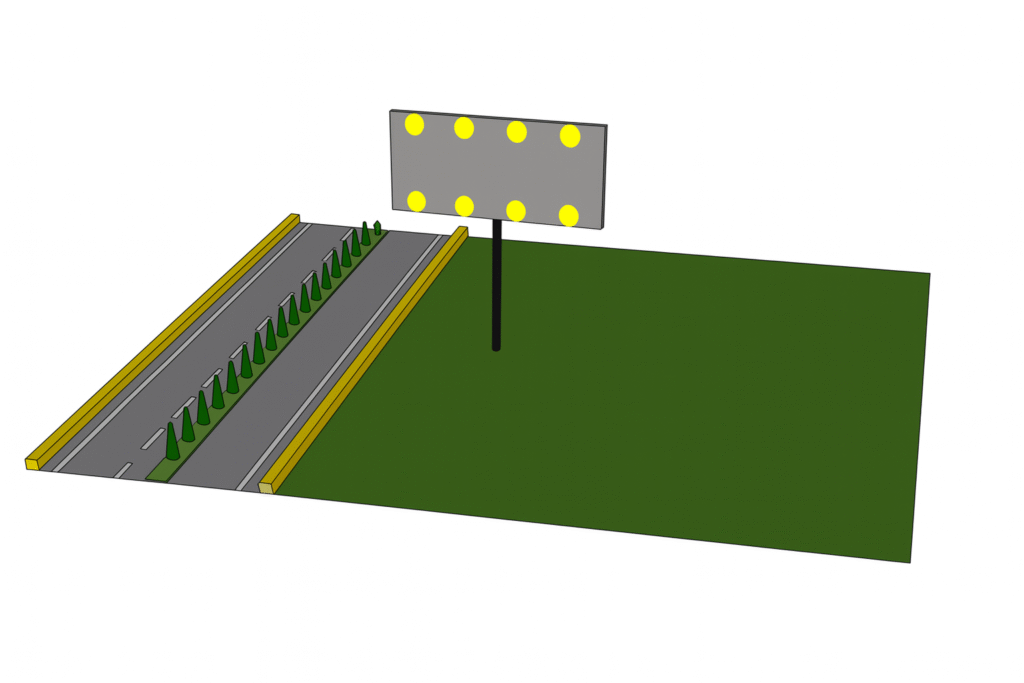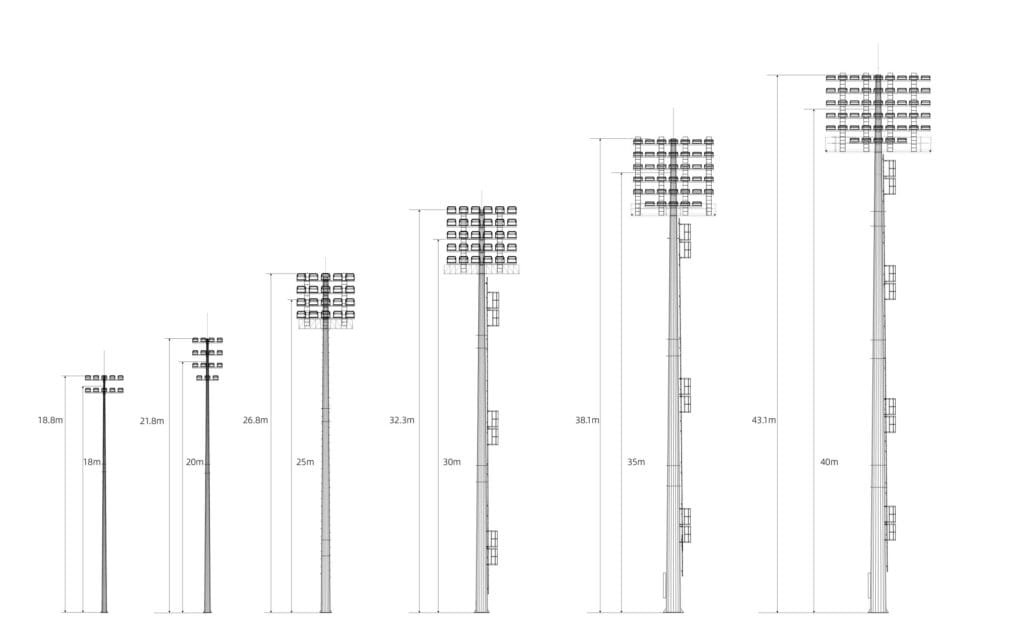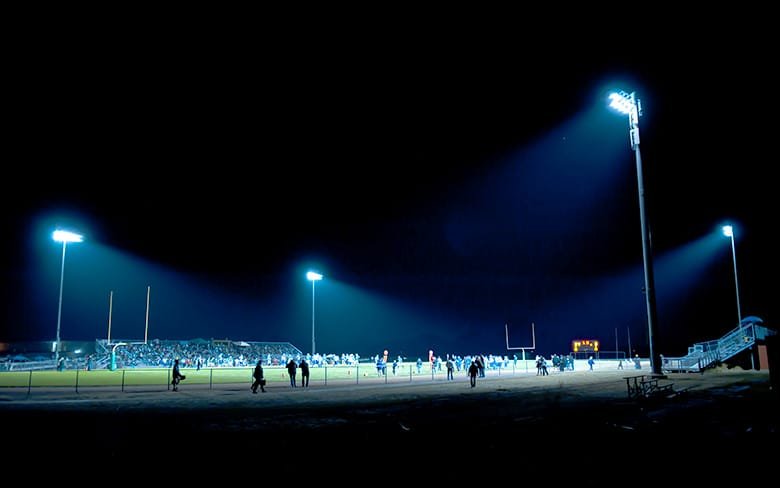In recent projects across Asia and the Middle East, we observed that with modern LED and hybrid AI control systems, most new stadiums can now reach 2000+ lux lighting levels while cutting power demand nearly in half.
These improvements have reshaped how sports and cultural events are seen — not only by the crowd in the stands but by millions watching through 4K and 8K broadcasts.
What Is High Mast Lighting?
High mast lighting refers to tall pole systems, typically 30–60 meters high, with multiple high-power LED luminaires arranged to deliver consistent light across wide areas such as stadiums, ports, and airports.
In stadiums, these masts create controlled, broadcast-level illumination that balances uniformity and atmosphere. The design demands more than wattage — it requires optical precision, wind resistance, and mechanical stability.
At Lusail Stadium in Qatar, our engineers faced a particular challenge: controlling glare for 8K cameras during humid evening matches. Twelve 52-meter towers, each carrying 160 luminaires (1400 W, CRI ≥90), were calibrated to stay within GR ≤19. After three nights of field adjustments and camera tests, the system reached 2000 lux average and 0.72 uniformity, fully compliant with FIFA standards.
That kind of fieldwork taught us that lighting design is rarely finished on paper — it matures on-site, under real heat and real deadlines.
High Mast Lighting Standards and Illumination Levels
Stadium lighting standards, such as FIFA and EN12193, define brightness and uniformity levels for fair play, safety, and global broadcast. In reality, achieving these targets requires balancing light geometry, structure stability, and glare control.
| Application | Average Illuminance | Uniformity | CRI | Glare (GR) |
|---|---|---|---|---|
| International Stadiums | around 1800–2200 lux | ≥0.7 | ≥90 | ≤19 |
| Training Fields | 300–800 lux | ≥0.6 | ≥80 | ≤22 |
| Multi-purpose Arenas | 1000–1500 lux | ≥0.7 | ≥85 | ≤25 |
In Abuja, Nigeria, the main difficulty wasn’t illumination but power stability. Grid voltage fluctuations forced our team to develop a solar-grid hybrid control. The final system, running 1824 lux average, switched seamlessly between power sources without flicker — a small detail that only field testing could validate.
In contrast, at Wankhede Stadium, India, where humidity reached 80%, maintaining fixture temperature became the limiting factor. We learned to reconfigure beam angles and heat sinks, trading 3% efficiency for reliability.
Lighting numbers tell part of the story; the other part lives in how those numbers hold up under pressure.
Performance Features of Stadium High Mast Lighting
Modern LED high mast systems merge optical precision, structural endurance, and smart control — yet each feature behaves differently in different climates.
- UHD Broadcast Quality: CRI ≥90 and uniformity ≥0.7 for 4K/8K coverage.
- Thermal Resilience: In tropical stadiums, managing fixture heat is often harder than increasing brightness.
- C5-M Coating: Prevents corrosion in humid or coastal zones, tested to 20+ year lifespan.
- Adaptive Control: DALI, DMX512, or IoT dimming lets operators adjust zones in seconds.
- AI Systems: Like at Riyadh’s King Saud University Stadium, optical sensors continually balance brightness, achieving 2000 lux with <0.5 s response time.
While luminous efficacy reduces fixture count, our experience shows thermal design and aiming accuracy are what keep systems stable after thousands of operating hours.
Energy Efficiency and Cost Considerations
LED and smart control systems can reduce energy use by 40–60%, depending on dimming schedules and event duration. Real results vary with climate and event frequency — our clients often see seasonal fluctuations of 5–10% in savings.
| Stadium | Energy Saving Range | Power Factor | Maintenance Reduction |
|---|---|---|---|
| Lusail, Qatar | 43–46% | 0.98 | ≈80% |
| Abuja, Nigeria | 45–48% | 0.96 | ≈82% |
| Mumbai, India | 37–40% | 0.97 | ≈75% |
| Manila, Philippines | 40–42% | 0.95 | ≈78% |
| Riyadh, Saudi Arabia | 42–44% | 0.98 | ≈85% |
Actual savings vary seasonally due to different event loads and lighting hours.
In Abuja, for instance, weekend tournaments required full output for longer durations, shifting energy savings slightly downward — a nuance often missed in design-phase estimations.
In Manila, the DMX + music-sync system wasn’t just aesthetic; it allowed precise zoning, reducing unnecessary load during partial-capacity events.
Efficiency, when done right, becomes both a technical and operational advantage.
Applications of High Mast Lighting in Stadiums
High mast lighting applies beyond sports arenas — airports, industrial yards, and civic spaces rely on similar design logic: stable poles, precise optics, and reliable control systems.
| Application | Typical Height | Lighting Range | Control Type |
|---|---|---|---|
| Stadiums | 40–55 m | 1500–2200 lux | DALI / DMX / AI |
| Airports | 35–45 m | 500–1000 lux | Smart Centralized |
| Ports & Yards | 30–45 m | 50–200 lux | IoT Monitoring |
| City Squares | 25–35 m | 100–500 lux | DMX512 |
During our Manila City Sports Complex project, we faced a unique urban challenge: road closures for night crane operations. Every lift between midnight and 4 a.m. required police coordination. Yet by completion, the arena could switch from basketball lighting to concert mode in seconds — proof that engineering and choreography can coexist.
Importance of High Mast Lighting Design and Simulation
Design simulation is where theory meets reality. Every mast height, optic angle, and wattage model must be validated under real constraints like weather, obstruction, and camera position.
Our design teams use DIALux and AGi32, but simulation never tells the full story. In Doha, after achieving perfect digital results, we still had to manually realign three towers due to wind vibration.
Similarly, Wankhede’s IoT system was tested under 1000 fps cameras to confirm zero flicker — an issue invisible to the naked eye but fatal to broadcast.
Stadium lighting design sits at the intersection of physics and emotion. Each aiming angle and color balance contributes not just to visibility, but to how fans feel when the floodlights ignite.
Global Project References: Lighting Beyond Boundaries
Five international projects illustrate how design principles adapt to real-world conditions.
| Stadium | Mast Height | Avg. Lux (Measured) | Uniformity | Energy Saving | Control | Distinctive Feature |
|---|---|---|---|---|---|---|
| Lusail, Qatar | 52 m | ~2000 lux | 0.72 | 43–46% | DALI + DMX512 | 8K broadcast-grade |
| Abuja, Nigeria | 48 m | ~1820 lux | 0.68 | 45–48% | PLC Hybrid | Solar-grid hybrid power |
| Mumbai, India | 45 m | ~2200 lux | 0.70 | 37–40% | IoT Dimming | Adaptive smart control |
| Manila, Philippines | 42 m | ~1500 lux | 0.75 | 40–42% | DMX + Music Sync | Event lighting flexibility |
| Riyadh, Saudi Arabia | 50 m | ~2000 lux | 0.70 | 42–44% | AI Optical | Real-time balancing |
Each project carried its own learning curve:
- In Qatar, humidity and camera glare were the hidden battles.
- In Nigeria, it was voltage instability.
- In India, it was heat management.
- In Philippines, synchronization between light and sound.
- And in Saudi Arabia, calibrating AI logic to human perception.
Real progress doesn’t happen in perfect symmetry — it happens in how engineers adapt.
Conclusion – Lighting the Arena, Illuminating the Human Spirit
Every time the lights come on, we’re reminded that precision engineering can shape emotion — and that’s what makes stadium lighting more than just illumination.
From Lusail’s 8K-ready towers to Riyadh’s AI-calibrated masts, these projects proved that light design is both art and discipline. Behind each successful illumination were nights of recalibration, safety checks, and quiet victories when all systems aligned.
When the crowd roars and the field glows evenly, it’s not just technology at work — it’s teamwork, persistence, and the small human details that make light feel alive.
CTA: Ready to design your next-generation stadium lighting system? Talk to our engineering team — we turn field data into illumination that performs.





